F5 Labs, in conjunction with our partner Baffin Bay Networks, set out to research global attack traffic by geographic region to gain a deeper understanding of the cyberthreat landscape. Aside from attack campaigns targeting the entire Internet (the IPv4 address space), the attack landscape varies regionally in terms of sources, targets, and attack types. In addition, targeted ports expose regional differences in IT norms. This can be seen when it comes to the way nonstandard ports are used for different services such as HTTP and SSH. In this latest data collection, we looked at malicious traffic over the same 90-day period in the U.S., Canada, Latin America, Europe, Russia, Asia, Australia, and the Middle East. (Note, for purposes of this research series, the Middle East includes Turkey, and excludes Middle Eastern countries that U.S. companies are not authorized to operate in.) This article covers attack traffic destined for systems in the Middle East from August 1, 2019 through October 31, 2019.
- The number one source of attacks targeting systems in the Middle Eastern came from IP addresses assigned to Russia, which launched more malicious traffic to the region than IP addresses assigned to the Netherlands, in second position. The Middle East was the most popular target of attacks sourced from Russian IP addresses.
- The top four IP addresses launching attacks against systems in the Middle East were assigned to Russia. These were abusive scans, largely looking for vulnerabilities on multiple ports. These IP addresses were not seen attacking other regions in the same time period.
- Rounding out the top 10 attacking IP addresses were those assigned to the Netherlands, Romania, and Moldova. These 10 IP addresses launched attacks on RFB/VNC1 port 5900, hitting all regions of the world.
- Of the top targeted ports, two were port 8291, used by MikroTik routers, and port 7547, used by Internet service providers (ISPs) to remotely manage their small office/home office (SOHO) router infrastructure. Combined, these ports received 3.7 million attacks. This activity is directly tied to the building of IoT botnets, also known as thingbots.
- The top ports targeted in the Middle East followed similar patterns as the rest of the world, with SMB port 445 as the top attacked port followed by SSH port 22, VNC port 5900, and HTTP port 80. Looking past the top 7 attacked services, the Middle East is the only region to see targeted malicious traffic directed at ports 81 (used for HTTP), 53 (used for DNS), and 8545 (used by Ethereum clients).
- In addition to the most frequently attacked ports, the Middle East was one of two regions to receive malicious traffic against Microsoft SQL server on port 1433, indicating databases, along with IoT devices, were a top target in that region.
Top Source Traffic Countries
Before we look at the “top source traffic countries,” let’s clarify that we’re talking about the geographical source of IP addresses. The “top source traffic countries” does not mean that the country itself, individuals, or organizations based in that country were responsible for the malicious traffic. The attack traffic could have gone through a proxy server or compromised system or IoT device with IP addresses assigned in a particular country. For expediency, we refer to these as “top source traffic countries.”
IP addresses assigned to Russia launched the most malicious traffic against systems in the Middle East from August 1, 2019, through October 31, 2019. The top 10 source traffic countries during this period were:
Russia
Netherlands
United States
China
Italy
France
Turkey
Moldova
Germany
South Korea
The top 10 were also the top source traffic countries globally.
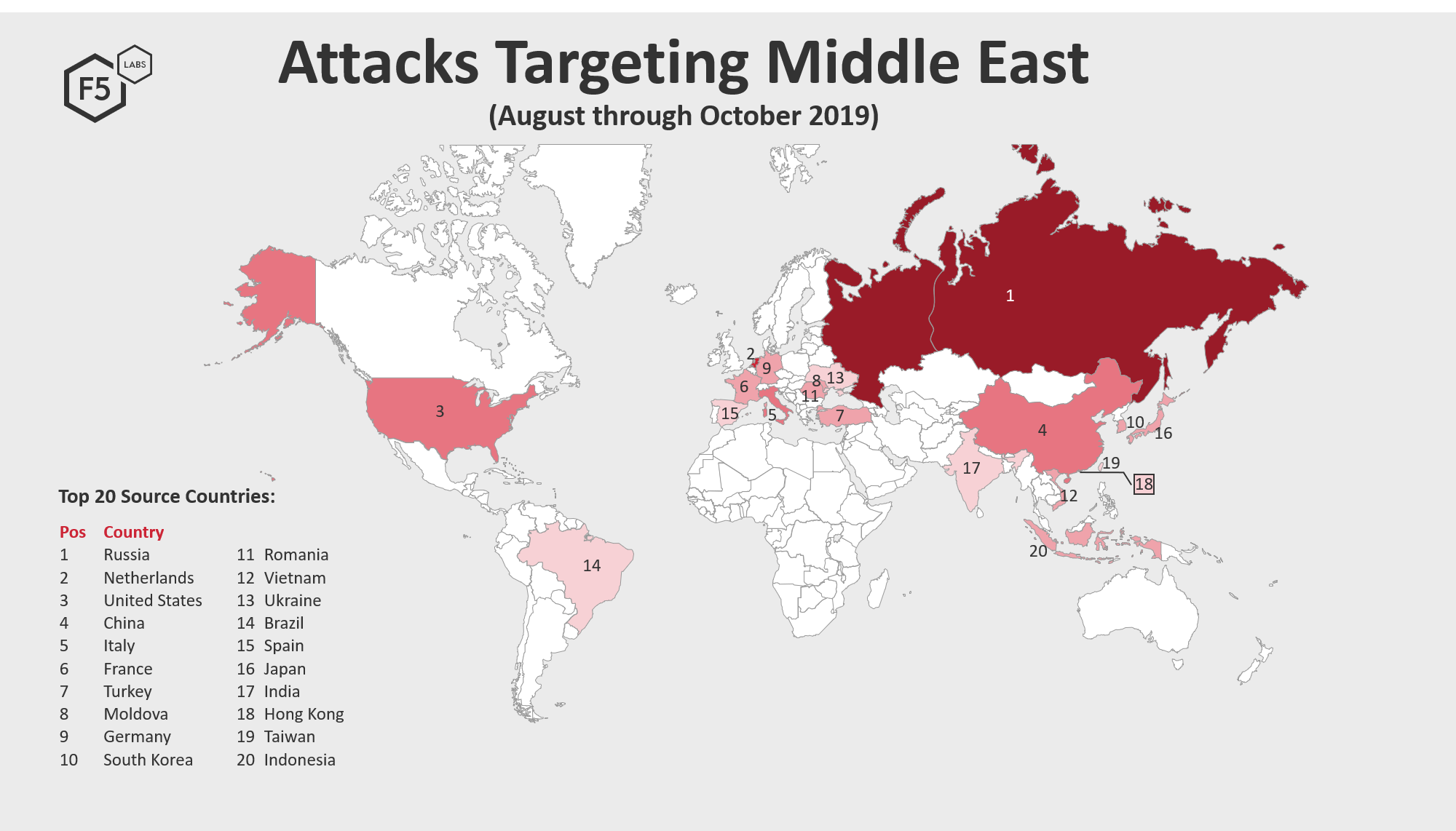
Figure 1. Source traffic countries launching attack traffic against targets in the Middle East, August through October 2019
IP addresses assigned in Russia launched 4 times the amount of attack traffic against systems in the Middle East than those registered in the Netherlands. Both the Netherlands and Russia are on the list for the top source traffic countries globally. These IP addresses launched nearly 11 times more malicious traffic directed toward the Middle East than they did toward the U.S., the second most targeted by these IP addresses. France, one of the top 3 source countries attacking other regions, is noticeably further down the list (at position 6). The Middle East also received a considerable amount of traffic from IP addresses assigned in Romania (position 11) and in Ukraine (position 13). The Middle East is one of two regions to receive malicious traffic from Romania, the other being Russia. In regard to the Ukraine, malicious traffic attributed to IP addresses assigned in Ukraine only targeted three regions: Russia, Europe, and the Middle East. Other than two IP addresses assigned in Ukraine that together launched a normalized 372,000 attacks, accounting for about one third of total traffic attributed to IP addresses assigned in Ukraine, no other IP addresses in Ukraine or Romania show up in the top attacking IP address list, discussed later. This indicates that attacks coming from IP addresses in those countries were more distributed; that is, they were launched from many IP addresses but had a low number of attacks per address. This type of activity is deliberate and takes more resources (systems and manpower) to pull off, and therefore is typically attributed to more sophisticated threat actors.
Note: The “normalized” attack count is not the total attack count collected, it is a calculated number considering the number of attack collection sensors region to region. We use normalized attack data in these reports in order to accurately compare attack data between regions and ensure that no one region is overrepresented in the total data analysis.
The Middle East is the only region to receive malicious traffic attributed to source IP addresses assigned in Spain. This only accounts for 1.6% of all malicious traffic August through October 2019.
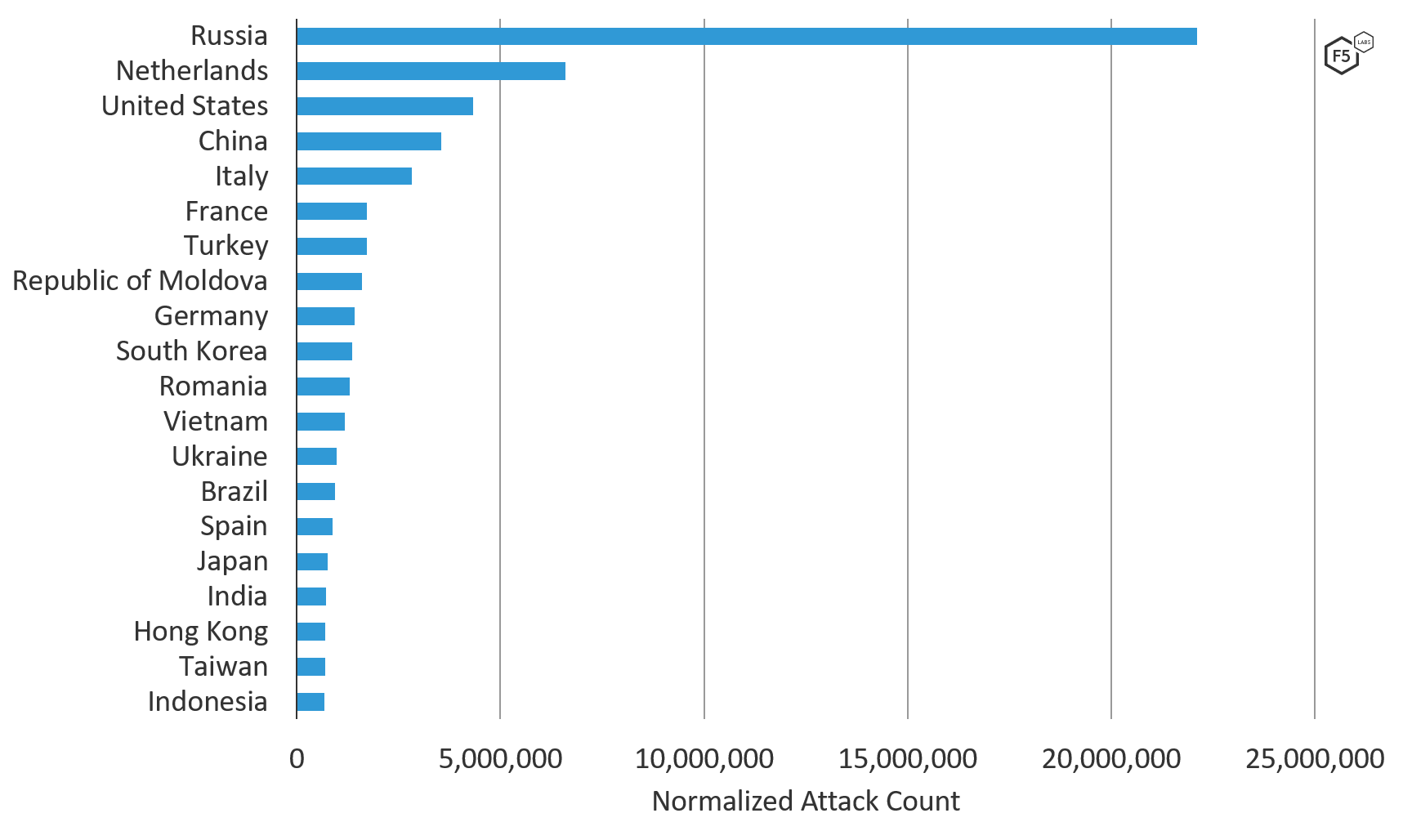
Figure 2. Top 20 source traffic countries (on a normalized scale) of attacks targeting systems in the Middle East, August through October 2019
Because IP addresses assigned to Russia launched so many attacks against systems in the Middle East during this period, we wanted to show a comparison of malicious traffic sourced from IP addresses in Russia directed to all regions analyzed around the world.
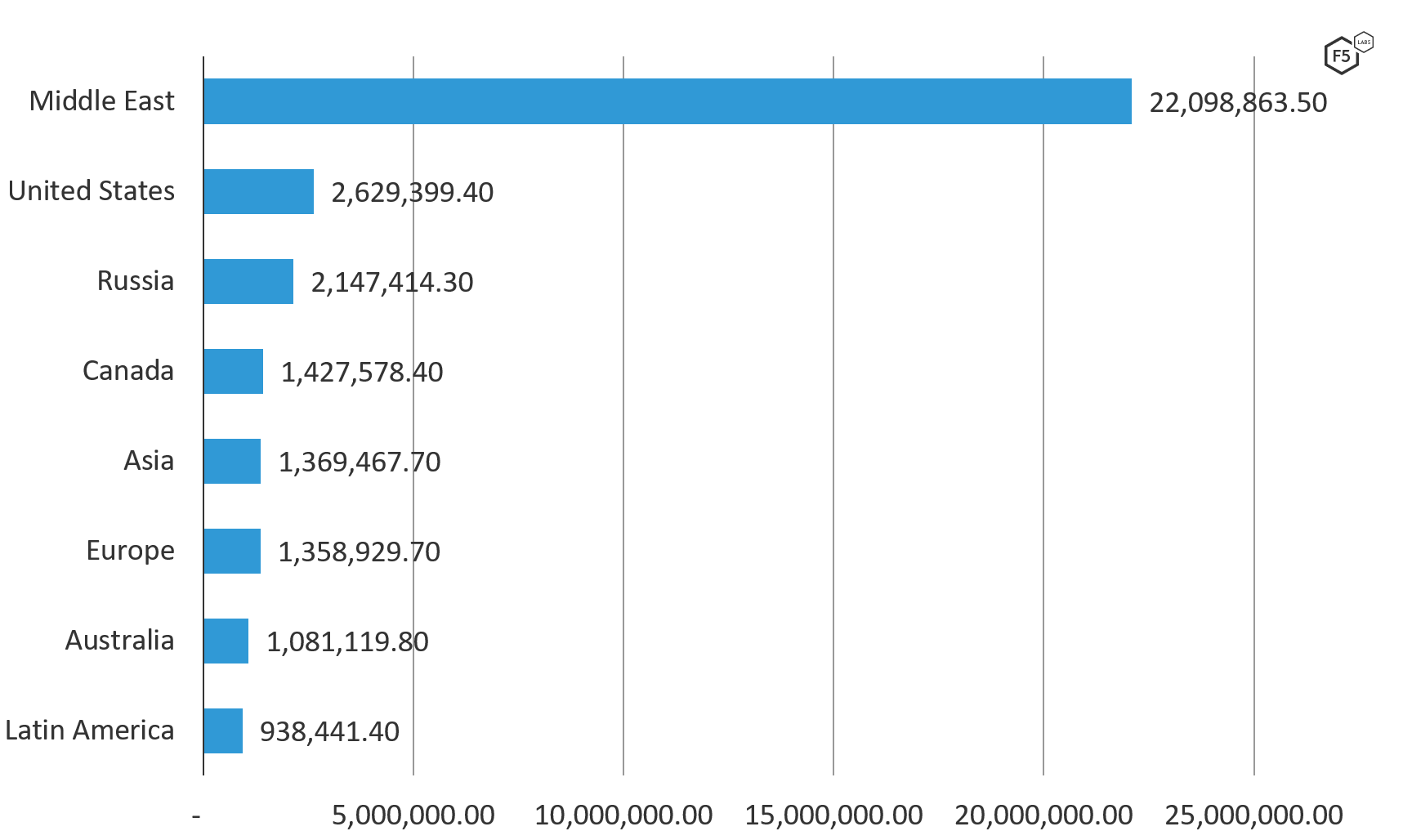
Figure 3. Normalized count of attack sourced from IP addresses assigned in Russia by geographical target, August through October 2019
Top Attacking Organizations (ASNs)
Petersburg Internet Network from Russia launched nearly double the attack traffic against systems in the Middle East than hosting provider Selectel (from the Netherlands), which was in second place. SS-Net in third position and MAROSNET Telecommunication Company LLC, in fourth position, are Russian. DigitalOcean, in sixth position, did not have any IP addresses show up on the top 50 attacking IP addresses list, which means the attacks were more evenly distributed across systems.
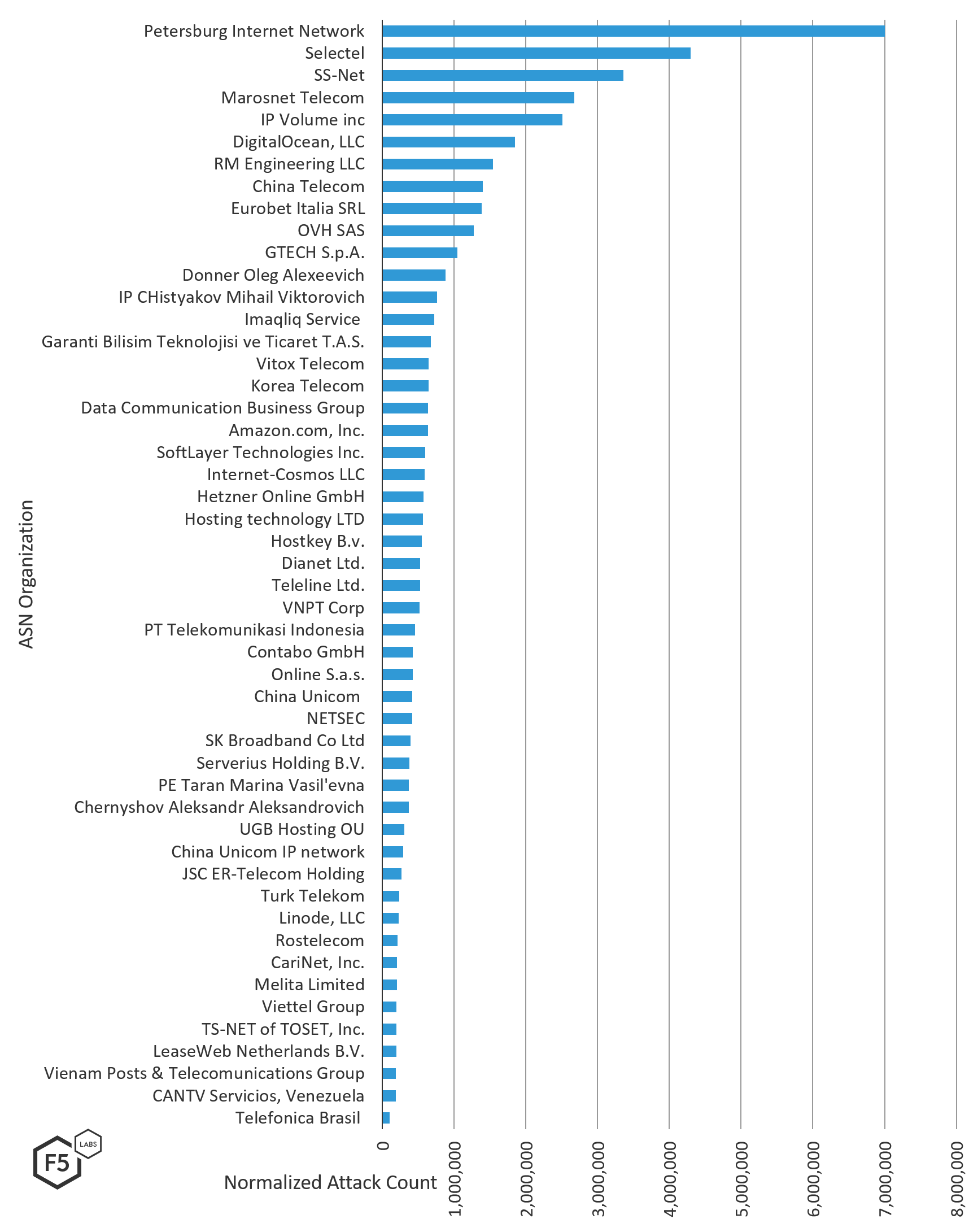
Figure 4. Source ASNs of attacks targeting Middle Eastern systems, August through October 2019
The following table lists ASNs and their associated organizations (note that some have multiple ASNs).
| AS Organization | ASN | Normalized Count |
| Petersburg Internet Network ltd. | 44050 | 7,007,052.50 |
| Selectel | 49505 | 4,294,692.00 |
| SS-Net | 204428 | 3,358,399.40 |
| Marosnet Telecommunication Company LLC | 48666 | 2,673,245.80 |
| IP Volume Inc | 202425 | 2,509,987.40 |
| Digital Ocean LLC | 14061 | 1,847,636.20 |
| RM Engineering LLC | 49877 | 1,539,218.70 |
| China Telecom | 4134 | 1,397,017.60 |
| Eurobet Italia SRL | 200944 | 1,385,536.10 |
| OVH SAS | 16276 | 1,273,846.40 |
| GTECH S.p.A. | 35574 | 1,041,995.50 |
| Donner Oleg Alexeevich | 35606 | 880,958.10 |
| IP CHistyakov Mihail Viktorovich | 35582 | 760,214.70 |
| Amazon.com, Inc. | 16509 | 632,401.90 |
| IMAQLIQ SERVICE Ltd | 12555 | 722,226.90 |
| Garanti Bilisim Teknolojisi ve Ticaret T.A.S. | 12903 | 678,935.70 |
| Vitox Telecom | 209299 | 645,652.90 |
| Korea Telecom | 4766 | 642,071.10 |
| Data Communication Business Group | 3462 | 632,553.00 |
| SoftLayer Technologies Inc. | 36351 | 595,028.20 |
| Internet-Cosmos LLC | 34300 | 588,531.50 |
| Hetzner Online GmbH | 24940 | 572,179.90 |
| Hosting technology LTD | 48282 | 567,631.60 |
| Hostkey B.v. | 57043 | 549,825.90 |
| Dianet Ltd. | 43314 | 527,897.80 |
| Teleline Ltd. | 13016 | 525,814.40 |
| VNPT Corp | 45899 | 520,675.70 |
| PT Telekomunikasi Indonesia | 7713 | 454,833.80 |
| Contabo GmbH | 51167 | 422,825.10 |
| Online S.a.s. | 12876 | 420,159.30 |
| China Unicom | 4837 | 416,594.10 |
| NETSEC | 45753 | 414,159.60 |
| SK Broadband Co Ltd | 9318 | 394,738.90 |
| Serverius Holding B.V. | 50673 | 375,209.20 |
| PE Taran Marina Vasil'evna | 51743 | 372,027.50 |
| Chernyshov Aleksandr Aleksandrovich | 202984 | 371,658.90 |
| Turk Telekom | 47331 | 238,842.50 |
| UGB Hosting OU | 206485 | 306,819.60 |
| China Unicom IP network | 133119 | 287,601.30 |
| JSC ER-Telecom Holding | 41786 | 266,715.80 |
| Rostelecom | 12389 | 210,051.20 |
| Linode, LLC | 63949 | 228,179.50 |
| CariNet, Inc. | 10439 | 201,691.90 |
| Melita Limited | 200805 | 200,896.40 |
| Viettel Group | 7552 | 197,330.10 |
| TS-NET of TOSET, Inc. in Japan | 55902 | 195,257.10 |
| LeaseWeb Netherlands B.V. | 60781 | 193,883.40 |
| Vietnam Posts and Telecommunications Group | 135905 | 188,628.80 |
| CANTV Servicios, Venezuela | 8048 | 187,967.50 |
| TELEFÔNICA BRASIL S.A | 27699 | 99,004.70 |
ASNs Attacking the Middle East Compared to Other Regions
We looked at the count of attacks by ASN toward Middle Eastern systems and compared that to other regions of the world. The key difference between attack traffic launched from networks targeting the Middle East versus the rest of the world is the volume of attacks launched from the top 4 networks targeting Middle Eastern systems—Petersburg Internet Network, Selectel, SS-Net, and MAROSNET Telecommunication Company LLC, (three Russian, one Dutch)—and the rest of the world receiving little to no attacks from the same networks. In contrast, top attacking networks in other regions like OVH SAS (France) and RM Engineering (Moldova) sent much less traffic toward Middle Eastern systems.
Top Attacking IP Addresses
The top 4 IP addresses attacking systems in the Middle East from August 1, 2019 through October 31, 2019 were all assigned in Russia and were engaged in either credential stuffing or in multi-port scanning, activities typically attributed to looking for vulnerabilities. Seventy-four percent of the IP addresses on the top 50 attacking IP addresses list engaged in the same multi-port scanning behavior, most of which are Russian.2 For a complete list of attacks by IP address, see section Attacks Types of Top Attacking IP Addresses.
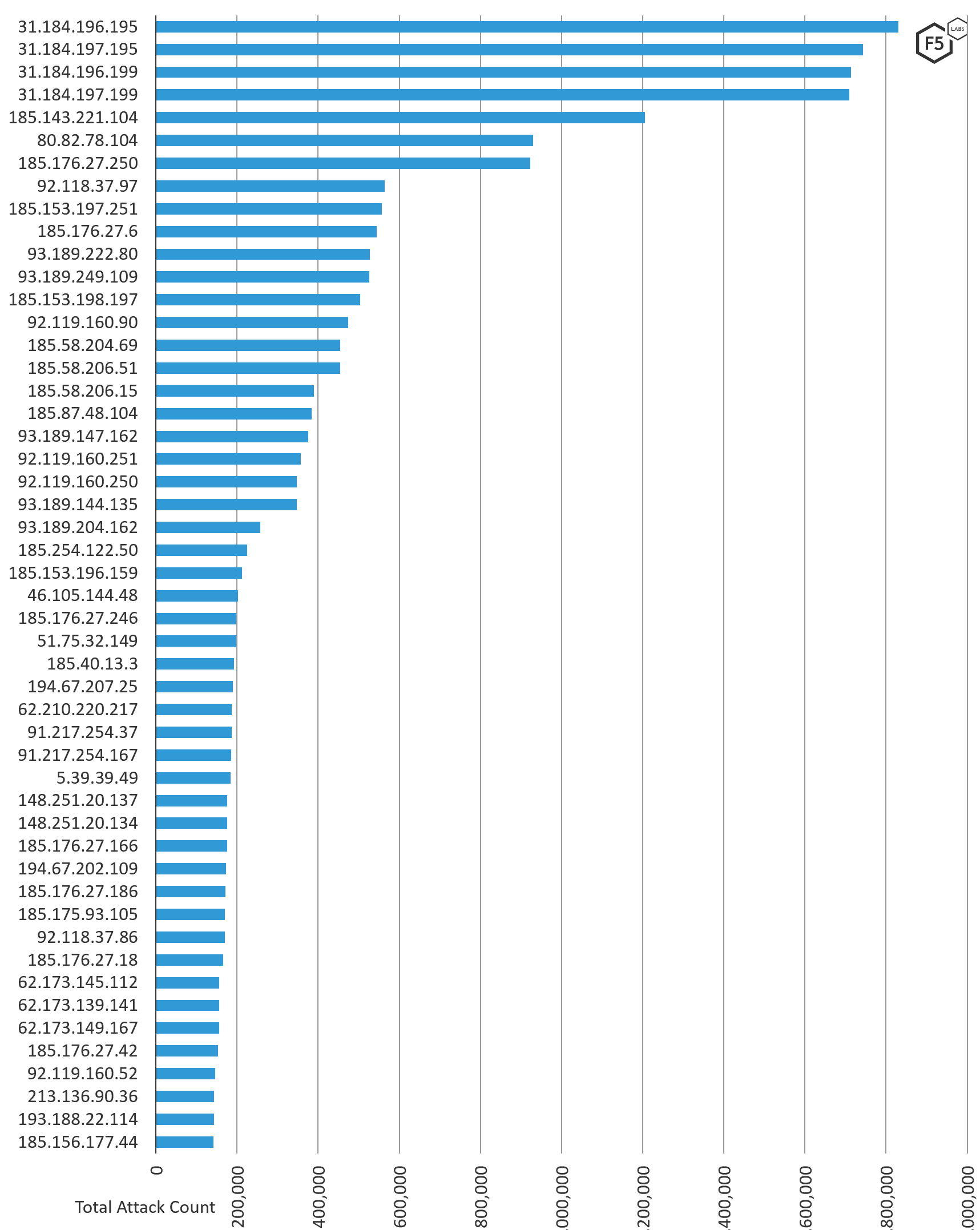
Figure 5. Top 50 IP addresses attacking Middle East targets, August through October 2019
IP Addresses Attacking the Middle East Compared to Other Regions
We looked at the volume of attack traffic Middle Eastern systems received per IP address and compared that to other regions of the world. Attack traffic destined for Middle Eastern systems had little overlap with the rest of the world except for a handful of IP addresses launching global attacks against RFB/VNC port 5900 (see the next section). Eighty percent of the top attacking IP addresses sending malicious traffic to the middle east were unique to the Middle East region, 16% of that top 50 were seen sending malicious attack traffic to all other regions in the world, and the remaining 4% were seen targeting 7/8 of the regions we looked at.
Attack Types of Top Attacking IP Addresses
Of the top 50 IP addresses attacking systems in the Middle East, most were Russian (64%). These IP addresses along with the remainder coming from the Netherlands (4%), Romania (4%), Moldova (6%), France (8%), Spain (2%), Germany (6%), Italy (2%), France (8%), and Ukraine (4%) are launching scans against multiple ports (49%), targeting port 80 and 8080 with HTTP attacks (5%), and targeting Remote Frame Buffer (RFB)/VNC port 5900 with brute force and credential stuffing attacks (19%).
The IP addresses in Moldova assigned to RM Engineering, as well as OVH SAS in France, were launching brute force and credential stuffing attacks against Remote Frame Buffer (RFB)/VNC port 5900, globally. All regions of the world are being hit with these same attacks from the following IP addresses:
- 185.153.197.251
- 185.153.198.197
- 46.105.144.48
- 193.188.22.114
- 185.156.177.44
- 185.153.196.159
- 5.39.39.49
- 185.40.13.3
These port 5900 attacks were new activity we noticed earlier in the summer and continued through October 31, 2019. We are conducting an investigation and will be looking to share our findings publicly on Twitter.
Eighty percent of the IP addresses seen sending malicious traffic to the Middle East exclusively targeted this region. The following list is in descending order starting with top attacking IP addresses.
| Source IP Address | ASN Organization | Country | Normalized Attack Count | Attacks Known For |
| 31.184.196.195 | Petersburg Internet Network | Russia | 1,830,560.5 | Multi-port scanning |
| 31.184.197.195 | Petersburg Internet Network | Russia | 1,743,359.4 | Multi-port scanning |
| 31.184.196.199 | Petersburg Internet Network | Russia | 1,713,624.0 | Multi-port scanning |
| 31.184.197.199 | Petersburg Internet Network | Russia | 1,709,400.9 | Multi-port scanning |
| 185.143.221.104 | Selectel | Netherlands | 1,205,687.1 | Multi-port scanning |
| 80.82.78.104 | IP Volume inc | Netherlands | 929,167.6 | Multi-port scanning |
| 185.176.27.250 | SS-Net | Russia | 922,830.2 | Multi-port scanning |
| 92.118.37.97 | Donner Oleg Alexeevich | Romania | 563,369.5 | Multi-port scanning |
| 185.153.197.251 | RM Engineering LLC | Moldova | 557,115.2 | Multi-port scanning |
| 185.176.27.6 | SS-Net | Russia | 544,818.3 | Multi-port scanning |
| 93.189.222.80 | DIANET Ltd. | Russia | 527,462.7 | Credential stuffing and HTTP attacks |
| 93.189.249.109 | Teleline Ltd. | Russia | 525,814.4 | Credential stuffing, multi-port scanning, and HTTP attacks |
| 185.153.198.197 | RM Engineering | Moldova | 503,611.6 | Credential stuffing and multi-port scanning |
| 92.119.160.90 | Selectel | Russia | 474,398.1 | Multi-port scanning |
| 185.58.204.69 | Marosnet Telecommunication Company LLC | Russia | 454,153.3 | Multi-port scanning |
| 185.58.206.51 | Marosnet Telecommunication Company LLC | Russia | 453,857.1 | Multi-port scanning |
| 185.58.206.15 | Marosnet Telecommunication Company LLC | Russia | 389,440.9 | Multi-port scanning |
| 185.87.48.104 | Marosnet Telecommunication Company LLC | Russia | 384,468.3 | Multi-port scanning |
| 93.189.147.162 | IMAQLIQ SERVICE Ltd | Russia | 374,878.9 | Credential stuffing, multi-port scanning, and HTTP attacks |
| 92.119.160.251 | Selectel | Russia | 356,754.9 | Multi-port scanning |
| 92.119.160.250 | Selectel | Russia | 347,531.5 | Multi-port scanning |
| 93.189.144.135 | IMAQLIQ SERVICE Ltd | Russia | 347,236.6 | Credential stuffing, multi-port scanning, and HTTP attacks |
| 93.189.204.162 | JSC ER-Telecom Holding | Russia | 256,840.9 | Credential stuffing, multi-port scanning, and HTTP attacks |
| 185.254.122.50 | UGB Hosting OU | Russia | 224,907.5 | Multi-port scanning |
| 185.153.196.159 | RM Engineering LLC | Republic of Moldova | 212,839.1 | Credential stuffing and multi-port scanning |
| 46.105.144.48 | OVH SAS | France | 202,142.7 | Credential stuffing and multi-port scanning |
| 185.176.27.246 | SS-Net | Russia | 198,532.4 | Multi-port scanning |
| 51.75.32.149 | OVH SAS | France | 198,274.3 | Multi-port scanning |
| 185.40.13.3 | GTECH S.p.A. | Italy | 192,255.5 | Multi-port scanning |
| 194.67.207.25 | MAROSNET Telecommunication Company LLC | Russia | 190,066.7 | Multi-port scanning |
| 62.210.220.217 | Online S.a.s. | France | 186,914.8 | Multi-port scanning |
| 91.217.254.37 | PE Taran Marina Vasil'evna | Ukraine | 186,263.8 | Multi-port scanning |
| 91.217.254.167 | PE Taran Marina Vasil'evna | Ukraine | 185,763.6 | Multi-port scanning |
| 5.39.39.49 | OVH SAS | France | 184,431.2 | Credential stuffing and multi-port scanning |
| 148.251.20.137 | Hetzner Online GmbH | Germany | 176,001.6 | Multi-port scanning |
| 148.251.20.134 | Hetzner Online GmbH | Germany | 175,726.6 | Multi-port scanning |
| 185.176.27.166 | SS-Net | Russia | 175,511.8 | Multi-port scanning |
| 194.67.202.109 | MAROSNET Telecommunication Company LLC | Russia | 172,302.0 | Multi-port scanning |
| 185.176.27.186 | SS-Net | Russia | 170,891.8 | Multi-port scanning |
| 185.175.93.105 | IP CHistyakov Mihail Viktorovich | Spain | 170,151.3 | Multi-port scanning |
| 92.118.37.86 | Donner Oleg Alexeevich | Romania | 169,713.6 | Multi-port scanning |
| 185.176.27.18 | SS-Net | Russia | 166,207.1 | Multi-port scanning |
| 62.173.145.112 | Internet-Cosmos LLC | Russia | 156,611.4 | Multi-port scanning |
| 62.173.139.141 | Internet-Cosmos LLC | Russia | 155,513.1 | Multi-port scanning |
| 62.173.149.167 | Internet-Cosmos LLC | Russia | 155,443.9 | Multi-port scanning |
| 185.176.27.42 | SS-Net | Russia | 152,556.9 | Multi-port scanning |
| 92.119.160.52 | Selectel | Russia | 145,908.0 | Multi-port scanning |
| 213.136.90.36 | Contabo GmbH | Germany | 143,881.3 | Credential stuffing and multi-port scanning |
| 193.188.22.114 | Hostkey B.v. | Russia | 142,707.9 | Credential stuffing and multi-port scanning |
Top Targeted Ports
Looking at the destination ports of the attacks helps us understanding what types of systems and services attackers are looking for. Microsoft SMB port 445 was the number one attacked port in the Middle East by a large margin. In a distant second was SSH port 22. Both of these ports are commonly targeted as exploiting a vulnerability, and either port can give a malicious actor access to the entire system. The third most attacked port, VNC 5900, was being attacked all over the world during this time period. This activity is not typical, hence the investigative threat hunting we are doing on Twitter mentioned previously.
What stands out the most in top attacked ports in the Middle East is the targeting of DNS port 53. That port does not show up in any other region we analyzed during the same time period.
In addition to some of the most commonly targeted ports, the number of non-standard HTTP ports (81, 8443, and 8080) and other application ports like Microsoft SMB port 445, and Microsoft CRM port 5555 makes it clear that attackers are targeting applications in the Middle East.
Also noteworthy is the apparent attempt to compromise IoT systems in the Middle East by targeting ports 7547 and 8291, both of which are only used by SOHO routers and are commonly attacked by IoT botnets (thingbots). We called out these ports in our 2017 report, The Hunt for IoT: The Rise of Thingbots.
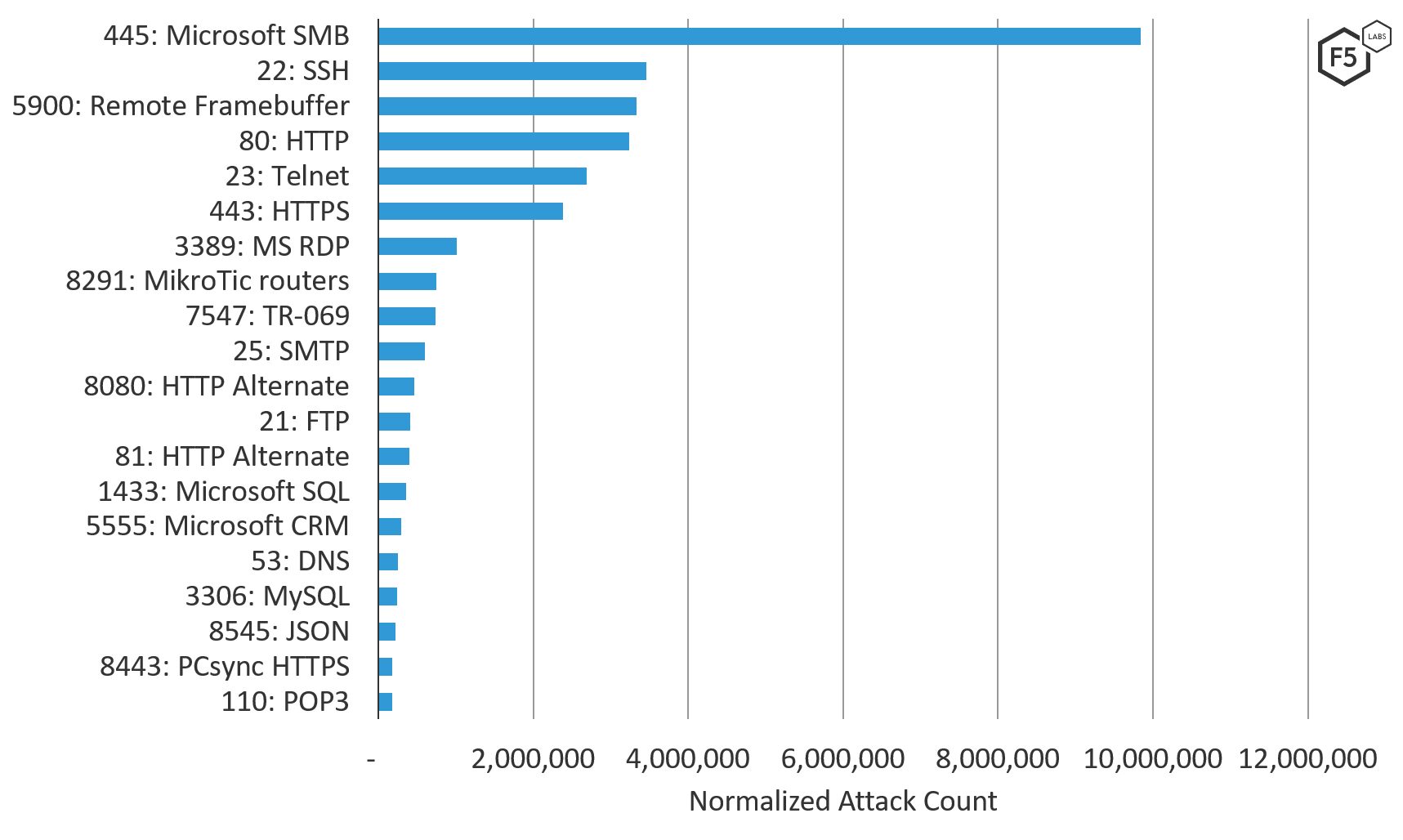
Figure 6. Top 20 ports attacked in the Middle East, August through October 2019
Conclusion
In general, the best approach a security team can take as defenders in this modern threat landscape is one of “assume breach.” This is not a FUD (fear, uncertainty, and doubt) position; rather, it’s a realistic position backed by the volume of attack traffic received by all Internet-connected systems, the likelihood of vulnerabilities existing, and the amount of compromised credentials available to attackers. When you take an “assume breach” defensive position, you are collecting attack traffic and monitoring your logs. You can use this high-level attack data to compare against the attack traffic directly hitting your own network. This will help you rule out run-of-the-mill attack traffic, or help you determine whether or not you are being targeted, in which case, investigating the attack sources and patterns is a worthwhile activity.
Additionally, locking down any of the top targeted ports that do not absolutely require unfettered internet access should be completed as soon as possible.
And because default vendor credentials are commonly left in place, and the volume of breached credentials in 2017 was enough to determine that many usernames and passwords are now considered “public,” all organizations should have credential stuffing protection in place. See F5 Labs report Lessons Learned from a Decade of Data Breaches for more data on these breached passwords. Particularly for any system with remote authentication, and especially administrative remote access.
Security Controls
To mitigate the types of attacks discussed here, we recommend the following security controls (/content/f5-labs-v2/en/archive-pages/education/what-are-security-controls.html) be put in place:
Recommendations
- Use firewalls to restrict all unnecessary access to commonly attacked ports that must be exposed publicly.
- Never expose internal databases publicly, and restrict access to internal data on a need-to-know basis.
- Prioritize risk mitigation for commonly attacked ports that require external access (like HTTP and SSH) for vulnerability management.
- Protect applications accessible over SSH using brute force restrictions.
- Disable all vendor default credentials (commonly used in SSH brute force attacks) on all systems before deploying them publicly.
- Implement geo IP address blocking of commonly attacking countries that your organization does not need to communicate with.


